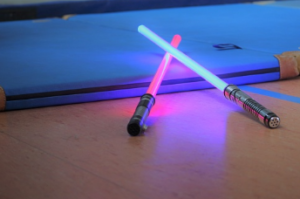Lightsabers are iconic weapons from Star Wars that can serve both defensively and as offensive swords in combat. They provide self-defense while remaining practical swords during fights.
 The lightsaber Australia hilt is often custom crafted and explicitly tailored to its wielder’s specific needs, style, and preferences. It features an integral Kyber crystal that powers its blade and is its focal point.
The lightsaber Australia hilt is often custom crafted and explicitly tailored to its wielder’s specific needs, style, and preferences. It features an integral Kyber crystal that powers its blade and is its focal point.
The blade
A lightsaber blade may look like it is composed of solid plasma, but there is much more beneath its surface. A lightsaber’s structure consists of a power cell and crystal energy chamber components linked through an activator crystal focus to form its final form.
Once activated, a primary crystal converts energy from its power cell into a refined arc wave that travels up the energy channel to past cycling field energizers, forming the blade.
This iconic weapon of Star Wars technology is used by both Jedi Knights and Sith Rulers to kill their enemies, making it one of the most recognisable pieces in its universe. They consist of a semi-weightless plasma blade that can be customised in lengths for optimal use. Programmability also provides another layer of flexibility.
Most Jedi prefer blue or red blades, though there are numerous colours to choose from – in fact, more modern practitioners employ an array of deadly hues in their deadly blades!
A Jedi lightsaber Australia blade takes on its colour from the crystal used to construct it – this crystal being Force-sensitive and taking on the hue associated with its owner as they use it, taking on different hues as a result wielded by someone within their ranks. Furthermore, their lightsaber can also be corrupted by Sith or dark side users to turn red, known as “bleeding.”
One aspect of Jedi blade design that’s often neglected is how their blade can also take the form of something other than a traditional light saber, such as a whip or lightclub weapon. Variations have even been featured in expanded media like “shoto,” typically found alongside traditional light sabers.
All lightsaber Australia share basic characteristics, including an alloy metal hilt and an elongated and curved blade. Some variations are more popular than others, yet each lightsaber has its own distinct look.
The hilt
The hilt is one of the most vital components of a lightsaber. It will determine its usability, its ability to be spun during battle, and how much control its user has over it, all factors which impact how its master performs attacks. Therefore, before buying one for yourself or as a gift, it’s important to consider its design and features carefully before purchasing your lightsaber.
The size and shape of hilts vary considerably across lightsaber models. Depending on a user’s fighting style, shorter hilts might be more suited to them – Yoda was known to favour shoto lightsabers, which resembled spears with diameters approximately half that of regular lightsabers.
Short hilts are more manageable for masters with limited strength, as they often feature choke points on the hilt, allowing users to spin and twirl the weapon when performing attacks. Furthermore, shorter designs often come equipped with choke points on their handles, allowing more precise weapon control when performing attacks.
Fans often find the appearance of lightsaber hilts appealing; perhaps a massive, rugged lightsaber with deeply grooved grip appeals, while others might prefer sleek designs with royal emitters and elegant emitter tips. Whatever their taste, masters must ensure their lightsaber fits them comfortably and looks good when displayed when not being used.
Another consideration when purchasing a lightsaber is its weight. While its blade may weigh less than its hilt, sabers remain cumbersome objects to carry around. According to Blue Monkey Sports, an average lightsaber hilt weighs 11 pounds (5 kilograms), making it hard for many users to hold and manipulate for extended periods.
Other than shape and weight, other considerations for lightsaber hilts include emitter position, if applicable, as well as handle design. A well-crafted handle may help provide comfort during use and maintain proper posture during combat – this also stabilises it to decrease the chances of blade slipperiness and blade tip misplacement.
The power source
Power sources play a significant role in lightsaber design. They provide energy to activate its blade and generate lethal plasma beams that render them lethal.
Jedi and Sith use force-sensitive Kyber crystals to power their lightsabers, amplifying small amounts of energy that enter. A power cell similar to what many household batteries provide feeds into these crystals and allows them to operate at maximum potential.